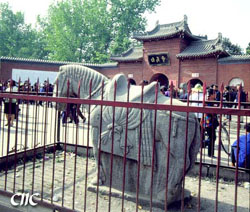 The Baima Temple (White Horse Temple) in Luoyang, Henan Province, was the first Buddhist Temple in China. It is said that one night in the year A. D. 64, Emperor Mingdi of the Eastern Han Dynasty (25-220) dreamed of a golden man 12 feet high, and the light from the man's head illuminated the hall where he stood.
The Baima Temple (White Horse Temple) in Luoyang, Henan Province, was the first Buddhist Temple in China. It is said that one night in the year A. D. 64, Emperor Mingdi of the Eastern Han Dynasty (25-220) dreamed of a golden man 12 feet high, and the light from the man's head illuminated the hall where he stood.
In the morning, the emperor told his officials what he had seen, and one of them, named Fu Yi, said the emperor had dreamed of the Buddha, a god of the West. Then the emperor sent Cai Yin, Qin Jing, and others to Tianzhu (now India) for Buddhist scriptures.
When Cai, Qin, and their group arrived in what is now Afghanistan, they met Kasyapamatanga and Dharmaranya, two eminent Indian monks, who were preaching Buddhism there. In A. D. 67, they loaded Buddhist scriptures written in Sanskrit and a portrait on white felt of Sakyamuni, the Buddha, onto a white horse and returned to Luoyang with the two Indian monks. The emperor lodged the monks at the Honglu Temple, which had a guesthouse for foreign emissaries. When living quarters for the monks were built in the temple the following year, the temple was renamed Baima (White Horse) Temple so people could remember the white horse that carried back the Buddhist scriptures and the portrait of Sakyamuni.
The Baima Temple has been through many changes. What we see today is a rectangular courtyard complex facing south, reconstructed during the Ming Dynasty (1368-1644), with an area of 40,000 square meters and a roofed entrance arch with three doorways. The entrance is built of blue stones, including several pieces from the Eastern Han Dynasty.
Arranged along a central axis that extends northward inside the entrance are the Hall of the Heavenly King, the Mahavira Hall, the Receiving and Directing to Paradise Hall, the Vairocana Pavilion, and the majestic Hall of the Giant Buddha, with its upturned eaves and painted brackets.
On the east side of the halls and the pavilion are the Guest Hall, the Hall of Prayer, the Hall of Abstinence, and the living chambers of the monks. On the west are the Hall of the Founder of Buddhism, the Hall of Meditation, and the Preaching Hall. There are two opposite courtyards, and the complex as a whole is well proportioned. It has the flavor of traditional Chinese architecture and shows a distinction between more important and less important structures.
All the halls housing statues of Sakyamuni, Maitreya, Amitabha, the Buddha of Medicine, and various bodhisattvas are built on the central axis following the terrain, and each hall stands higher than the one in front. The Vairocana Pavilion on Qingliang Terrace stands especially prominent and magnificent.
The Qiyun Pagoda was built after the temple was renamed Baima Temple and is known as the first pagoda in China. Originally, it was a pavilion-like wooden structure with paintings depicting Buddhist scriptures. It burned down toward the end of the Northern Song Dynasty (960-1127) and was rebuilt in 1175 as a 13-story square brick structure with closely arranged eaves. It is 25 meters in height and 7.8 meters on each side at the bottom. The eaves are built with small, exquisite overlapping bricks.
When one claps one's hands 20 meters away from the pagoda, the echo reflected from the eaves sounds like frogs croaking.
Admission: 35 yuan (US$4.4)
Transportation: It takes one hour?s time by taking bus 56 with nonstop.
Open Time: 7:30-18:00
(china.org.cn May 16, 2003)
|

